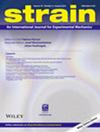Speckle pattern creation methods for two‐dimensional digital image correlation strain measurements applied to mechanical tensile tests up to 700°C
IF 2.4
3区 材料科学
Q2 MATERIALS SCIENCE, CHARACTERIZATION & TESTING
引用次数: 2
Abstract
The purpose of this study is to develop novel speckle pattern techniques for digital image correlation (DIC) kinematic measurements of mechanical tests at high temperatures, typically from 400 to 700°C. In this context, the speckle pattern should not only meet morphological criteria (size, density, distance) in order to improve spatial resolution, but it should also present a high contrast and resist high temperature and strain levels. To find a speckle pattern matching these specifications, a comparison was performed on six types of speckle made using different techniques. First, a computer‐generated speckle pattern that meets DIC criteria was numerically designed to produce six types of speckle pattern. Next, the speckle patterns produced using these six techniques were compared in terms of speckle morphology, image quality and adherence to titanium alloy TA6V material at high temperatures. From 25 to 600°C, the speckle pattern made by the technique combining anodisation and laser engraving named M5 technique gave the best contrast (highest value of mean intensity gradient [MIG] and Shannon entropy value) and the adherence of 200% of strain measurements to the TA6V material. At 700°C, speckle image quality is considerably reduced due to oxidation of the titanium alloy, and this may not be suitable for DIC measurements. Only the speckles produced by painting in which the paint plays a protective role provide with a better speckle contrast compared with other techniques. However, these speckle patterns enable only a strain measurement of 22% by the DIC method. This article concludes with guidelines for producing a speckle pattern suitable for high‐temperature mechanical tests.用于高达700°C的机械拉伸测试的二维数字图像相关应变测量的散斑图案创建方法
本研究的目的是开发新的散斑图案技术,用于在高温(通常为400至700°C)下进行机械测试的数字图像相关(DIC)运动学测量。在这种情况下,散斑图案不仅应该满足形态学标准(尺寸、密度、距离)以提高空间分辨率,而且还应该呈现高对比度并抵抗高温和应变水平。为了找到符合这些规范的散斑图案,对使用不同技术制造的六种类型的散斑进行了比较。首先,对符合DIC标准的计算机生成的散斑图进行了数值设计,以产生六种类型的散斑图案。接下来,从斑点形态、图像质量和在高温下对钛合金TA6V材料的粘附性方面比较使用这六种技术产生的斑点图案。从25到600°C,由阳极氧化和激光雕刻相结合的M5技术制成的散斑图案具有最佳对比度(平均强度梯度[MIG]和Shannon熵值的最高值),并且200%的应变测量值与TA6V材料的粘附性。在700°C下,由于钛合金的氧化,散斑图像质量显著降低,这可能不适合DIC测量。与其他技术相比,只有油漆起到保护作用的绘画产生的斑点才能提供更好的斑点对比度。然而,这些散斑图案仅能够通过DIC方法进行22%的应变测量。本文最后介绍了产生适用于高温机械测试的散斑图案的指南。
本文章由计算机程序翻译,如有差异,请以英文原文为准。
求助全文
约1分钟内获得全文
求助全文
来源期刊

Strain
工程技术-材料科学:表征与测试
CiteScore
4.10
自引率
4.80%
发文量
27
期刊介绍:
Strain is an international journal that contains contributions from leading-edge research on the measurement of the mechanical behaviour of structures and systems. Strain only accepts contributions with sufficient novelty in the design, implementation, and/or validation of experimental methodologies to characterize materials, structures, and systems; i.e. contributions that are limited to the application of established methodologies are outside of the scope of the journal. The journal includes papers from all engineering disciplines that deal with material behaviour and degradation under load, structural design and measurement techniques. Although the thrust of the journal is experimental, numerical simulations and validation are included in the coverage.
Strain welcomes papers that deal with novel work in the following areas:
experimental techniques
non-destructive evaluation techniques
numerical analysis, simulation and validation
residual stress measurement techniques
design of composite structures and components
impact behaviour of materials and structures
signal and image processing
transducer and sensor design
structural health monitoring
biomechanics
extreme environment
micro- and nano-scale testing method.
 求助内容:
求助内容: 应助结果提醒方式:
应助结果提醒方式:


